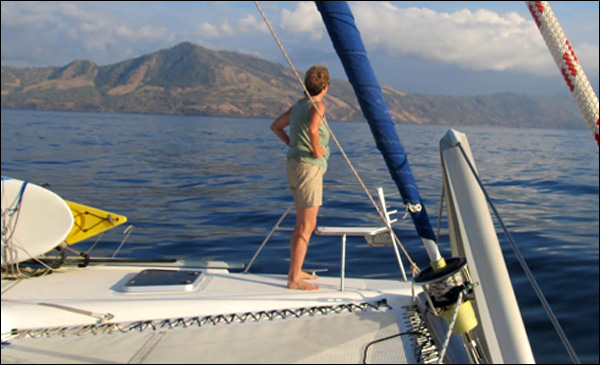
“So? Whaddya think?”
Everybody’s asking us. They want to know what we — 20+ year veterans of monohulls — think about our first eight-week catamaran experience cruising aboard a 50 foot cat? Some anticipate utter conversion, some expect loyalty, others could care less about the boat and want to hear about the trip.
Comparing catamarans to monohulls based on our experience is not even a question of comparing apples to oranges, but rather THIS apple to THIS orange.
Individually and together, Don and I have 20+ years experience on one boat type, the CSY 44 cutter, a 20-year old production boat, but the sum total of our catamaran experience is the eight weeks we’ve sailed with friends aboard Quantum Leap, an 11-year-old semi-custom St. Francis 50.
You might think these two boats would have nothing in common, but to us they do. The first is that both boats were constructed on principles of solid construction and strength. This results in a heavier boat for its class, perhaps not as fast as others, but with a more secure-feeling ride in heavy conditions.
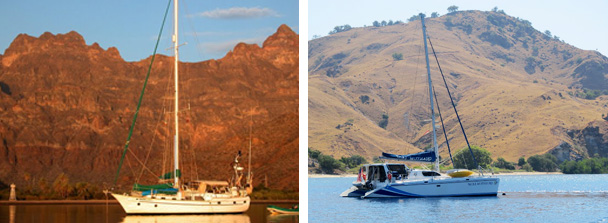
The second is more abstract. It has to do with feel. I loved the look of our CSYs, particularly Tackless II (T2), the walk-thru. The classic lines and color choices we’d made for paint, canvas, and even bottom paint pleased me approaching across an anchorage. I truly appreciated her cool, comfy, breezy cockpit and 360* view, while inside, I loved the welcoming feel of the honey-toned carved woodwork, the decor we’d chosen, most of the layout and the generous natural light from her big salon windows.
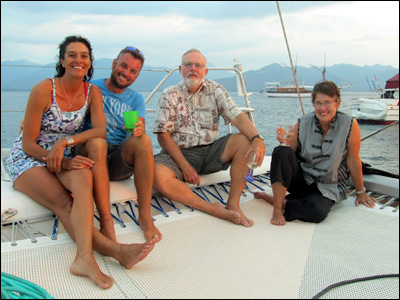 |
| Tom and Bette Lee Walker (right) aboard Quantum Leap |
When we first met Tom and Bette Lee Walker in Fiji, their boat struck us similarly, with handsome aesthetics, fine joinery, and pleasing layout. Like most tire-kickers, we’ve walked on and off a lot of catamarans, at boat shows and socially, and rarely have we had that reaction of, “Yeah, I could do this one.” We had it right away with Quantum Leap (QL).
So we were thrilled to be invited to meet up with QL in Darwin, Australia for the first leg of the Sail Indonesia Rally to Bali.
Right off, we appreciate one of the big advantages of a catamaran, the room to have guests aboard.
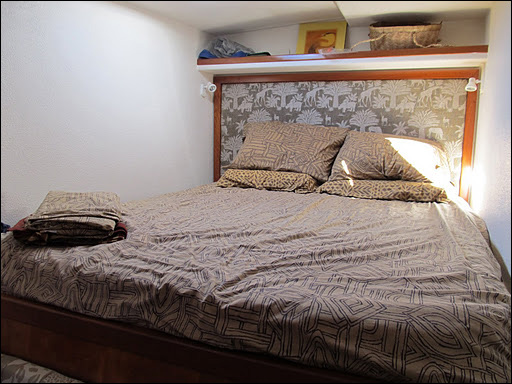 |
| Guest berth aboard QUANTUM LEAP |
On T2 our guest cabin had filled up with stuff, but on QL we have a whole hull to ourselves, a queen berth with ensuite head, generous lockers to put clothes away, and even a spare cabin in which to pile our empty suitcases! Head-in on the bridge deck, our berth is comfortable and well-ventilated with plenty enough headroom — nice for sleeping or an afternoon reading getaway.
The cabins are all open because this cat has tons of interior and exterior lockers, so that deck gear, spares, and provisions are all put away. Even on deck, only their windsurfer and kayak are secured to a lifeline; all fuel jugs are in an external locker making for a very clear deck. Not the case on T2!
Space, of course, is the main reason people first consider catamarans: the extra cabins for family or guests, the spacious cockpits for meals and partying, the wide open deck for lounging about.
The second main reason is stability.
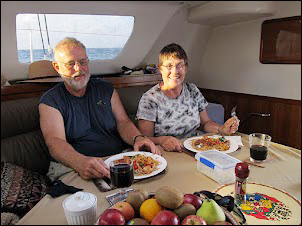 |
| Seat down meals on Quantum Leap |
Expected at anchor, it’s mind boggling how much stuff is just left sitting in place underway. Granted we’ve not made a major ocean crossing like a trip to New Zealand or the Indian Ocean, but, literally, coffee cups are just left sitting on counters! On a monohull, that would be risky at anchor!
However, while stuff takes the catamaran ride easily, we don’t do as well. The quick jostle of a cat underway makes moving around the huge deck unsettling. Here the space works against you with few handholds available. There’s plenty of room to manhandle the downwind pole into place, but personally, we feel like wobbly toddlers, totally vulnerable. Our hostess says they, too, had second thoughts about the motion initially, “but it’s something you get used to.”
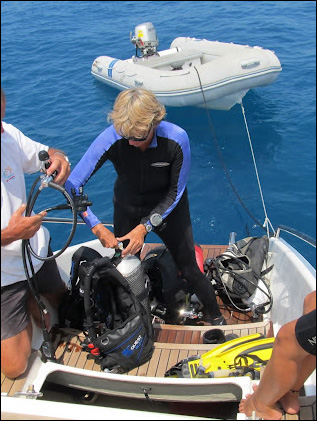 |
| We love the easy access to the water |
Things we especially like are the electric winches and the way most lines can be worked from the cockpit area.
We love the ease of hoisting the dinghy with the outboard in place onto the aft deck via a hinged davit, a pair of tackles, and a halyard led to one of the electric winches.
We also love the easy access to the water for swimming, fishing and boarding the dinghy, and the perfectly-placed deck shower.
The bow seats on each pontoon are favorite reef and sunset watching spots underway…once we stagger up to them, but they are also convenient for bracing one’s butt when doing anything on the precariously narrow bows! However, I’m surprised how little we’ve used the trampolines or sat out on deck. Our first day under sail Don and I took Paradise seats on deck to read, but after that, in this UV conscious era, the lure of being in the hot sun has been way down.
But on the other hand, in the cockpit, we don’t like the lack of forward view typical of most catamarans. Yes, for safety, we can see forward through the salon windows, but it’s not the same as a 360* panorama. Nor as breezy. Underway the raised helm seat gives a good view, but for anyone else to see ahead, they must stand on the bench seat or step out on deck.
An eyebrow-raising negative of catamarans is their infamous “slapping”, the product of waves thwacking the underside of the bridge deck. It was particularly alarming on our one rough, 30-knot night passage. We’re told this happens less on higher-bridged cats, but none escape side slapping. Admittedly, our monohull occasionally pounded when hard on the wind in big seas. Another thing one gets used to?
On the maintenance side, there is, of course, twice the waterline to clean but also the very huge deck to get dirty. It’s mighty nice to have private heads, but it means there are four toilets and four showers sumps to keep up. Likewise, there are two engines to maintain, and engine access (on this boat under the aft berths) is a bit harder, so daily checks of engine fluids can be a pain (though far better on QL than cats whose engines are beneath storage lockers!) It could easily make them vulnerable to out-of-sight-out-of-mind negligence.
Speed, of course, is a third attraction of cats.
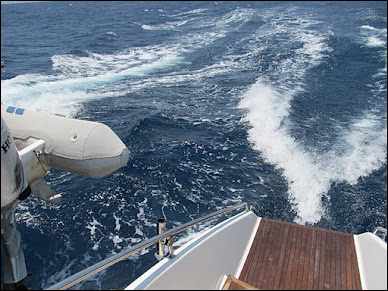 |
QL is well-loaded down, but from a monohuller’s perspective she makes great speed, under sail and under power, even at low RPMs on one engine.
The option to motor on just one engine is excellent (using only .5-.75gph), but not all cats have this choice if essential systems are divided between engines.
The biggest negative of catamarans is expense. The initial cost is more than double what you would spend on a monohull that would get you going sooner, plus you have to plan for extra costs to berth and to haul. (Of course, cats do have the nifty option of drying out on a tidal cycle for bottom work, something we saw several do on the beach in Darwin.)
But, after eight weeks, we feel really at home on QL. So, yeah, we’d consider two hulls on “a next boat.” It’d be perfect for taking the family to the Keys or Bahamas.
It’s just a matter of that lottery ticket coming in.
This article was published in the Nov/Dec 2011 issue of Latitudes and Attitudes.
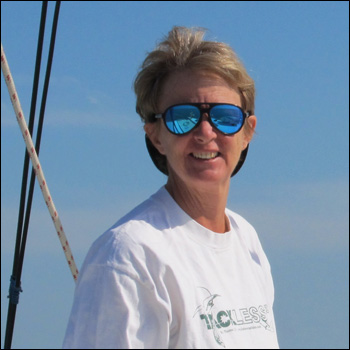
Oooops! A couple of photos on this post are NOT on Quantum Leap, specifically the first photo of me in the sun hat at the helm and the shot of our berth. Both these photos are from Ivory Street, discussed in the next column. We’ll get this fixed ASAP.
I enjoyed your views on this. Friends who crossed the Atlantic when we did have cruised many years on a monohull and last year delivered a big cat from the Caribbean across the Atlantic and on down to Africa (near Dakar). A long ocean passage not downwind. They never got used to the jerky and unpredictable (according to them) motion. They are not in the market for a cat.